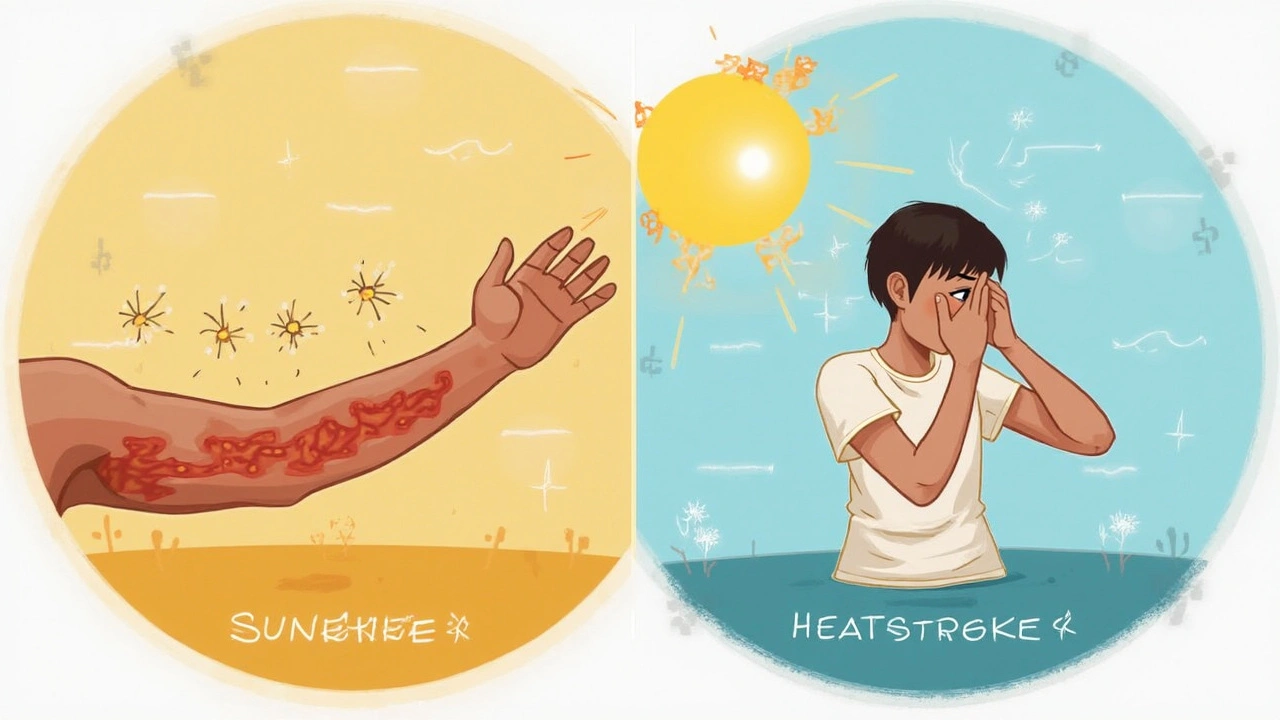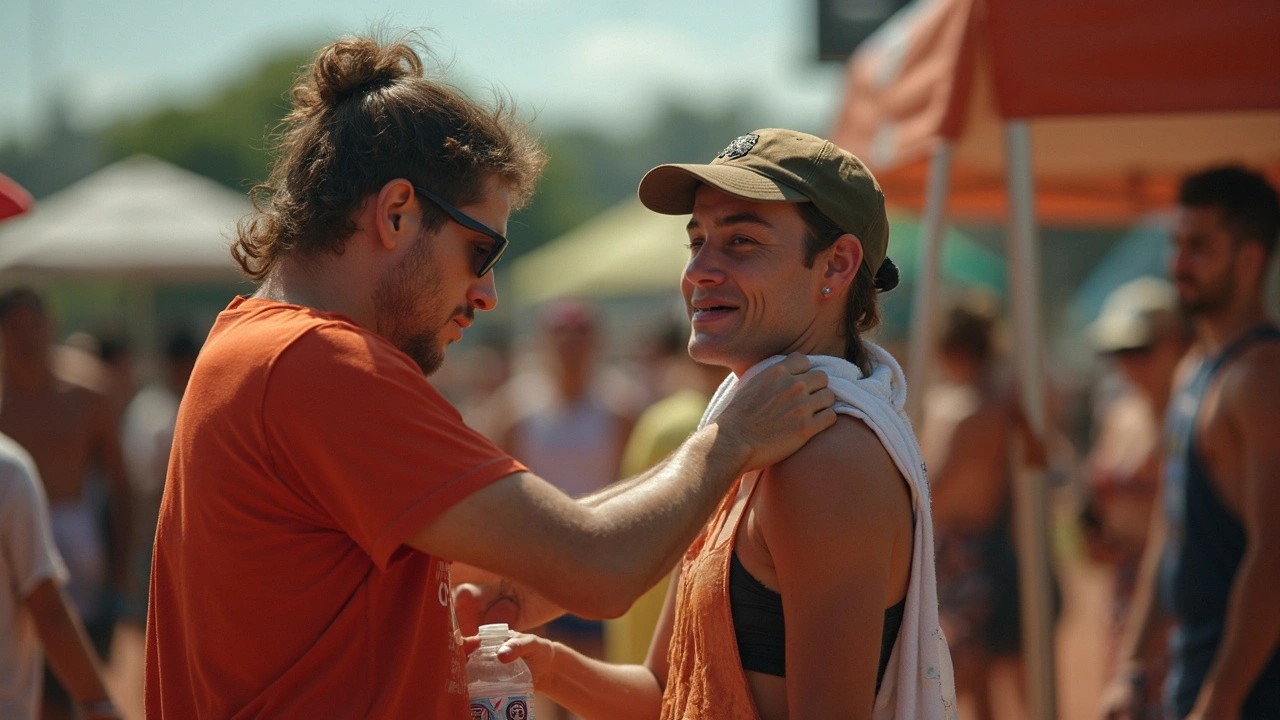Stepping out into the summer sun feels like a reward after endless months spent indoors. The blue sky, the splash of water, the taste of cold lemonade—these memories stick. But sunburn or heatstroke can turn even the best day on its head. When lying by the pool turns into feeling woozy, or your skin sizzles just under your T-shirt, you know you’ve pushed your body. Most folks think they know the difference between these two troublemakers, but mix them up when it matters. Both can sneak up fast. The trick is knowing what’s what, so you can act fast and stay out of the danger zone. Let’s look at how your body signals the warning and what you can really do if the sun bites back.
The Science Behind Sunburn: Why Your Skin Pays the Price
Ever wake up surprised by the wicked red outline of yesterday’s tank top? That’s sunburn in action—a direct hit from the sun’s ultraviolet rays, usually UVB, attacking your skin’s outer layers. Your skin isn’t just annoyed—it’s hurt. DNA inside your skin cells actually gets damaged, and your immune system quickly shows up to fix things. The classic redness, swelling, and heat? That’s your body trying to heal the harm.
Did you know it only takes about 15 minutes for unprotected skin to start burning if the UV index is high? The sting, the itch, sometimes even chills or fever. Your body sees sunburn as an injury, just like a scrape, but on the cellular level. And you don’t just get burned at the beach—sunburn happens hiking, driving with the window open, or messing around in the garden. Even cloudy days can be dangerous! Around 80% of UV rays cut right through clouds. That’s part of why people underestimate risk.
The scariest part is that sunburn adds up over the years. You might forget one sunburn, but your skin remembers. Getting burned just five times before age 20 more than doubles your odds of deadly skin cancer, like melanoma, later in life. It isn’t just about the pain tonight—it’s about your future health.
Who burns fastest? Fair-skinned people, kids, anyone with certain meds that make skin sensitive (antibiotics, some acne meds), and those living at higher altitudes. The closer you get to noon, the greater the risk. Sunglasses and broad-brimmed hats aren’t just fashion—they’re shields.
Here’s a quick table with facts to help you spot and remember the risk:
| Factor | Increases Sunburn Risk? |
|---|---|
| Time of Day (10am-4pm) | Yes |
| Cloudy Weather | Yes (UV still passes through) |
| Reflection (water, snow) | Yes (doubles exposure) |
| Sunscreen (SPF 30+ used correctly) | No (greatly lowers risk) |
If you start to feel hot, stiff, or notice your skin is tender after being outside, go inside quickly, get cool, and drink water. The golden rule: If you see redness or feel a sting, the work’s already begun beneath your skin. The healing will take a few days, but staying out through the whole burn only makes it worse. Try aloe or after-sun lotions if it happens, and don’t scratch or peel!
Heatstroke: The Silent Threat Lurking in the Sun
You might’ve heard people say “I have heatstroke” as a way to describe feeling overcooked outside, but true heatstroke is a different beast. Unlike sunburn, which is a skin problem, heatstroke is a full-body meltdown. Your body’s main cooling method—sweating—gives up when things get too hot and humid, and suddenly your core temperature rockets above 104°F (40°C). That’s when organs start to shut down. What’s wild is heatstroke can hit even if you never get sunburned, and it can be deadly in under an hour if ignored.
The first signals are sneaky: headache, nausea, cramps, or confusion. Maybe you stop sweating, feel dizzy, or your skin gets dry and hot. Kids, athletes, older folks, and anyone working outside risk it most—there’s a reason marathon runners or roofers are constantly being told to take breaks and hydrate. Did you know over 700 people in the U.S. die each year from extreme heat, mostly from heatstroke? It sounds small, but when you consider all the ways it can be prevented, it’s heartbreaking.
Your brain is especially vulnerable. Confusion and slurred speech are giant red flags. Someone might suddenly collapse or act drunk. If you see that, don’t wait—get help NOW. Medical pros treat it like an emergency, because that’s what it is. The faster the person cools off, the better their chances.
Here’s the big difference: Sunburn hurts but rarely kills. Heatstroke feels bad fast and can kill in hours, even if you look totally fine at first. The scariest heatstroke cases often happen during heatwaves, with victims indoors and fans blowing but no true AC. Always check in on people you know who are elderly, ill, or living alone during hot weather.
Quick reality check: sitting in a car with even the windows cracked can turn deadly on a hot day. Temperatures inside skyrocket in under 10 minutes, and children and pets cannot cool down fast enough. The slogan ‘look before you lock’ isn’t just for show. Never leave anyone inside a parked car, even for a quick errand.

Spotting the Difference: Sunburn vs. Heatstroke Symptoms Explained
It’s easy to mistake an uncomfortable sunburn for something more dangerous, especially when you’re wiped out after a day in the sun. But knowing which signals belong to sunburn and which spell heatstroke can make all the difference—sometimes, it literally saves lives.
Let’s lay out the most common symptoms side by side:
| Symptom | Sunburn | Heatstroke |
|---|---|---|
| Red, painful skin | Yes | Maybe (if with burn, but not typical) |
| Peeling, blistering skin | Often | No |
| Fever or chills | Sometimes (mild) | Yes (usually high fever) |
| Confusion, stumbling | Rare | Common, serious sign |
| Rapid pulse/breathing | No | Yes |
| Absence of sweat | No | Yes (late heatstroke) |
| Nausea/vomiting | Can occur (rare) | Common |
If someone is acting confused, vomiting, unable to walk normally, or stops sweating—even if their skin is red—suspect heatstroke and get medical help immediately. Sunburn usually comes with a clear boundary where the skin turns red (like between shorts and thighs) and doesn’t usually produce high fever or mental confusion. You might feel tired or slightly feverish after a bad burn, but you’ll know the difference if you suddenly can’t think straight or feel like passing out.
Sometimes, these conditions overlap—like getting badly sunburned while suffering mild heat exhaustion, a step before true heatstroke. If you’re already burned, your body is worse at cooling itself, so sunburn can push your risk higher.
Treatment That Works: Real-World First Aid and Home Care
So you got burned, or maybe you’re seeing someone fade fast in the summer sun—what’s the move? Quick, simple actions work best and can make a huge difference right away. Harry Potter doesn’t need to show up with a spell book; just a little knowledge and speed.
- For Sunburn:
- Get indoors or into the shade as soon as you notice redness or discomfort.
- Cool your skin gently with compresses, lukewarm baths, or cool showers. Avoid super-cold water; it can make things sting more.
- Drink water to rehydrate. Sunburn can dry you out even if you haven’t been sweating much.
- Try an aloe vera gel or after-sun lotion for soothing relief. Many people swear by plain, fragrance-free moisturizers too.
- Over-the-counter pain meds like ibuprofen help with pain and swelling—just follow the box instructions.
- Avoid tight clothing, hot baths, or picking at peeling skin. Peeling is your body’s way of shedding dead cells safely.
- For blisters, don’t pop them—leave them alone if you can, since that covers healing skin underneath.
- If skin blisters cover more than 20% of your body, or you have trouble breathing, confusion, or high fever, see a doctor.
- For Heatstroke:
- This is a true emergency. Call 911 or your local emergency line immediately—every minute counts.
- Move the person to shade or an air-conditioned spot right away.
- Lay them down and raise their legs a little if possible. Cool them with cold packs placed at the neck, armpits, and groin. You can use any cold drinks on hand, ice packs, or even a garden hose for rapid cooling.
- If they’re awake and able to drink, offer small sips of cool water (don’t force it if they’re vomiting or can’t swallow).
- Never give anything by mouth if the person is acting confused or unconscious.
- Take their temperature if you can; over 104°F means it’s definitely heatstroke territory.
- Do not wait for help to arrive before starting cooling measures.
Most people fully recover from sunburn with a little home care, but with heatstroke, things can get serious quickly. Quick action is key. Studies show survival rates are much better when cooling starts immediately—don’t waste time, jump in with what you have. Never hesitate to get help if you’re unsure which you’re dealing with.

Easy Ways to Prevent Sunburn and Heatstroke Before Trouble Starts
Prevention is where you get the best bang for your buck—seriously, each step you take makes the next “bad day” in the sun far less likely. No need to live indoors all summer. A little planning pays off way more than the price of aloe or an ER visit.
- Sunscreen 101: Go for SPF 30 or higher and look on the label for “broad spectrum” to block both UVB and UVA rays. Apply 15-30 minutes before heading out and reapply every two hours, even on cloudy days. Don’t forget easy-to-miss spots, like ears, neck, tops of feet, and backs of knees.
- Clothing: Choose lightweight, long-sleeved shirts, wide-brimmed hats, and sunglasses with real UV protection. Darker colors actually block more UV than light ones.
- Pay Attention to Weather Alerts: If you see a high UV index or heat advisory, take it seriously. Plan outdoor time for before 10 am or after 4 pm when rays are weaker and temps cooler.
- Stay Hydrated: Sip water throughout the day, even when you’re not thirsty. Avoid alcohol and sugary soda, which can speed up dehydration. If you’re sweating heavily, consider drinks that replace lost salts.
- Give Yourself a Break: Take regular shade or indoor breaks if you’re out for more than an hour, especially from noon to 3 pm.
- Mind Medications and Risk Factors: If you take meds that make you sun-sensitive (certain antibiotics, antidepressants, acne treatments), wear extra protection and stay vigilant. Ask your doctor if you’re unsure.
- Look out for Each Other: Kids, seniors, and pets rely on you to keep track of time in the sun. Remind friends, check in during heatwaves, and never leave anyone in a hot car.
- Cooling Gadgets: Carry a spray water bottle, cooling towel, or small umbrella for extra shade—small tricks add up fast in the heat.
The goal? To enjoy every day under the sun by sidestepping the worst stuff it can throw at you. Don’t let sunburn or heatstroke be your summer souvenir. Stay observant, stack your odds, and hit the shade when your body tells you it’s had enough.



Alissa DeRouchie
May 17, 2025 AT 17:36Sunburn's just a badge of honor lol
Emma Howard
May 29, 2025 AT 07:23Great rundown! I love how you broke down the signs so clearly. Remember to reapply sunscreen every two hours, especially after swimming. Hydration is key-keep a water bottle handy all day. Stay safe and enjoy the sunshine!
dee gillette
June 9, 2025 AT 21:09While the article provides a comprehensive overview, it arguably overstates the prevalence of heatstroke in comparison to sunburn. Epidemiological data suggests that sunburn incidents far outnumber heatstroke cases in most temperate regions. Moreover, the recommended preventive measures, though sound, lack nuance regarding individual skin phototypes. A more stratified approach would enhance efficacy. The inclusion of a risk matrix could further guide readers. Nonetheless, the effort to educate the public is commendable.
Jasin P.
June 21, 2025 AT 10:56Ah, the good old American summer-where the sun is practically a weapon. Apparently we need a PhD to figure out not frying ourselves. The article politely tells us to drink water, as if that’s a newsflash. Yet, we keep sprinting to the grill anyway. Maybe the next edition should include a flag‑waving reminder that we’re the toughest under the heat.
Lily Đàn bà
July 3, 2025 AT 00:43Behold the tragedy of the careless beach‑goer, doomed by a misplaced SPF! The sun, relentless, mercilessly brands those who ignore its blaze. One sees the pale‑skinned victims, the rags of burned flesh, and shudders. Let this be a warning: the heavens spare no fool, and the heatstroke specter looms for the lazy. Rise, take shelter, or become a cautionary tale etched in crimson.
Joseph O'Sullivan
July 14, 2025 AT 14:29Well, if we consider the sun as a metaphorical forge, then indeed we are all being hammered into something. But perhaps the real question is why we willingly step into the furnace. It’s a dance of desire and danger, my friend. The heat tests our limits, and we claim mastery while we’re merely surviving.
Conor McCandless
July 26, 2025 AT 04:16In the grand theater of summer, each ray is a spotlight, each droplet of sweat a prop, and the unwary soul a tragic protagonist-forsaken by hubris and the cruel whims of the atmosphere; the narrative unfolds with blistered skin serving as an indelible scar upon the canvas of memory, a reminder that nature’s grandeur does not bend to mortal complacency; let the audience heed the chorus of warning cries, the whispered counsel of older generations, the silent counsel of the wind that sighs through the trees, for only then can the drama transition from catastrophe to cautionary triumph.
kat gee
August 6, 2025 AT 18:03Totally agree-hydrate like it’s your job! Sunscreen is the real MVP. Stay cool and have fun out there.
Iain Clarke
August 18, 2025 AT 07:49Thank you for the detailed analysis. It’s helpful to see the data-driven perspective. I’d add that community outreach programs can address the gaps you mentioned. Providing free sunscreen at public events could be a practical step. Let’s keep the conversation constructive.
Courtney Payton
August 29, 2025 AT 21:36i think people forget that even on cloudy days u can still get burned its a common myth. also hte body loses water faster than u realize when it's hot. its not just about staying in shade but also about wearing proper clothes. i guess we all need to be more aware of the signs before it gets too late.
Muthukumaran Ramalingam
September 10, 2025 AT 11:23Honestly, I have seen many folks think a light breeze will save them, but the truth is dehydration sneaks up like a thief in the night. When the temperature climbs you start to feel a little tired then suddenly your head feels like it’s in a oven and you just can’t think straight. It's not just a simple matter of drinking water once; you need electrolytes, salts, and constant small sips. And if you ignore the early signs, the heat can take over your body’s cooling system and you end up in the emergency room with a story nobody wants to repeat. So please, plan your breaks, wear a hat, and never underestimate the power of a simple water bottle.
Garrett Williams
September 22, 2025 AT 01:09Stay cool, stay safe, and keep enjoying those summer vibes!
joba alex
October 3, 2025 AT 14:56while u think "vibes" are enough the reality is that UV index metrics and thermoregulation protocols are being ignored by most youth demographic it's not just a feeling it's a physiological hazard that requires quantifiable mitigation strategies.
Rene Lacey
October 15, 2025 AT 04:43The sun, in its indifferent brilliance, offers both life-giving warmth and the peril of overexposure.
To navigate this duality, one must cultivate an awareness that borders on the scientific and the experiential.
First, recognize that ultraviolet radiation does not discriminate between a beach towel and a laboratory bench.
The epidermal cells, when assaulted, initiate a cascade of inflammatory mediators that manifest as the familiar redness of sunburn.
This physiological response, while painful, serves as an evolutionary alarm bell, urging the organism toward shade.
In contrast, heatstroke represents a systemic failure of thermoregulation, where the core temperature breaches the survivable threshold.
The brain, heart, and kidneys all suffer when the coolant-sweat-evaporates insufficiently.
Early symptoms such as confusion and absent diaphoresis are not merely inconveniences but harbingers of organ failure.
Consequently, rapid external cooling, preferably via ice‑water immersion, becomes a life‑saving imperative.
Preventive measures, however, should not be reduced to a checklist of sunscreen and water bottles.
They must encompass behavioral adjustments: seeking shade during peak UV hours, wearing reflective garments, and monitoring ambient heat indexes.
Moreover, cultural practices that valorize stoic endurance in the face of heat often exacerbate risk, especially among vulnerable populations.
Public health messaging, therefore, ought to intertwine scientific data with empathetic storytelling to resonate across demographics.
By integrating personal anecdotes of near‑misses with clear practical guidelines, societies can shift the narrative from fatalism to empowerment.
Ultimately, respecting the sun’s power while embracing its gifts is a balanced act that demands both knowledge and humility.
johnson mose
October 26, 2025 AT 18:29What a masterclass in sun‑science! You’ve turned a health guide into poetry. I love the call for storytelling-makes the facts stick like caramel on a warm porch. Let’s keep spreading these vibrant lessons, and maybe someday the heatstroke myth will finally melt away.